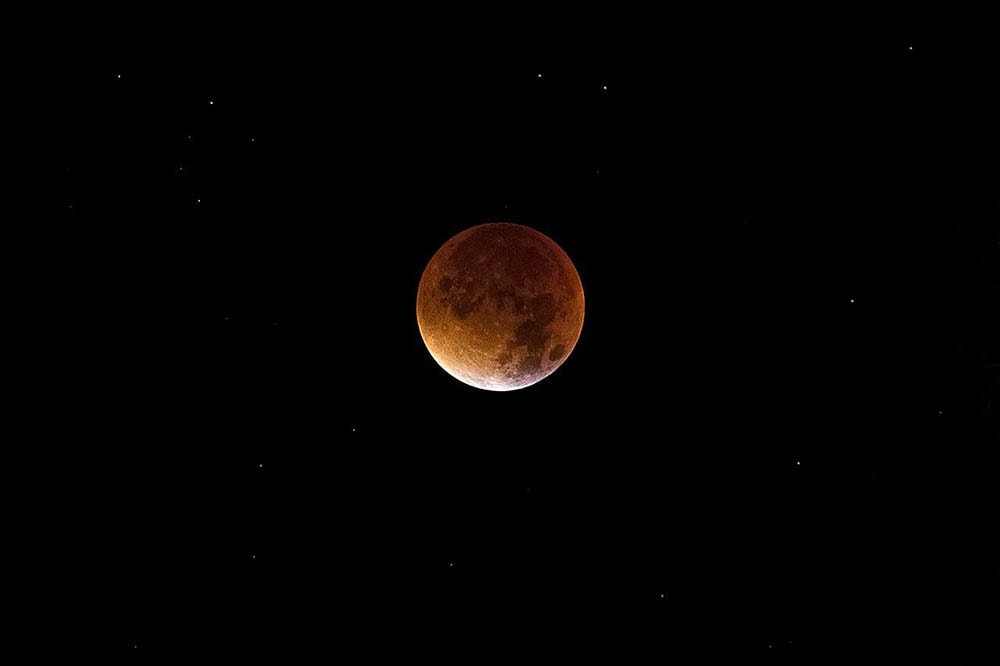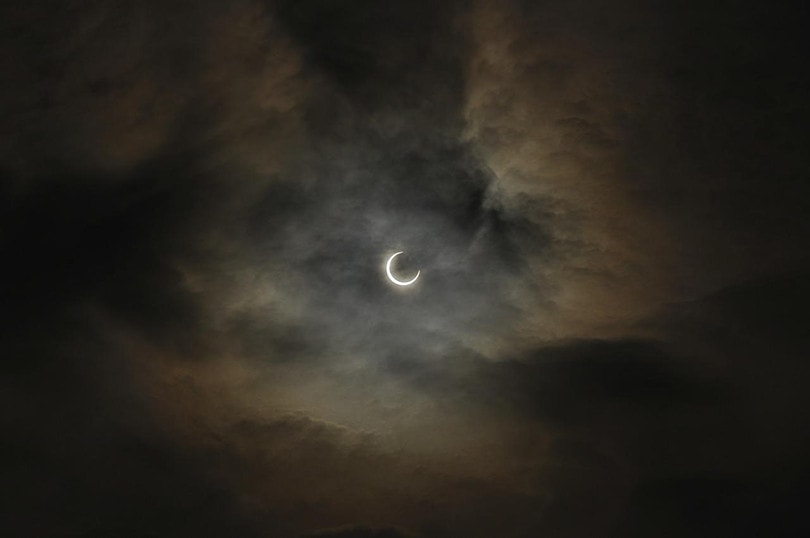9 Interesting Facts About Lunar Eclipses You Never Knew
Last Updated on

Lunar eclipses are some of the most spectacular and breathtaking cosmic phenomena. They have puzzled, scared, and inspired awe in humans for centuries and continue to help us understand our humble place in the universe.
There’s plenty to know about lunar eclipses, so if you’re excited about seeing the next one, brush up on your trivia skills and keep reading to learn nine fun and interesting facts about lunar eclipses.
Top 9 Facts About Lunar Eclipses
1. Lunar Eclipses Occur Multiple Times Per Year
If the Earth and Moon’s orbits around the Sun were in the same plane, we would see a total lunar eclipse every month. However, because the Moon’s orbit is inclined by about 5.15° to the ecliptic, or the Sun’s orbital plane, the Earth’s shadow usually passes either above or below the Moon. However, these orbits will meet at their nodes twice a year, which defines the eclipse season.
During this time, we can see either a partial lunar eclipse or, sometimes, a rare total eclipse. During eclipse season, at least one solar and one lunar eclipse are guaranteed, allowing for the possibility of a lunar eclipse occurring at least twice per year. In some very rare cases, under perfect conditions, we might even be able to observe three lunar eclipses a year.

2. Lunar Eclipses Only Occur During the Full Moon
Lunar eclipses will only occur when the full moon is positioned perfectly in line with the Earth and Sun in a configuration called syzygy. Syzygy is simply astronomical terminology for a straight-line configuration of three or more bodies in a gravitational system. If the Sun, Earth, and Moon are not aligned perfectly, the chances of seeing a total lunar eclipse fall to zero. Anything less than perfection in this alignment can lead to a partial lunar eclipse or no eclipse at all.
The reason we see lunar eclipses at all is a complete coincidence and the result of the Sun and Moon’s relative size and distance from each other. By pure happenstance, the Sun’s diameter is about 400 times larger than the Moon’s. Furthermore, the Sun is approximately 400 times farther than the Moon from Earth. This combination of metrics means that when viewed from Earth, the Sun and Moon appear to be the same size. This is the reason for us seeing eclipses at all and why there must be a full moon for us to see a lunar eclipse.
3. Refraction Causes the Moon to Look Red During an Eclipse
The deep, sinister, red hue of the totally eclipsed moon has inspired fear and awe in people for centuries. Although this unique attribute of lunar eclipses seems reminiscent of a sci-fi movie, it actually has a simple explanation. The phenomenon responsible for this effect is called Rayleigh scattering, which is the same reason the sky on Earth is blue during the day and a gradient of warm colors during sunset. Blue light has a shorter wavelength than red light, so it is more easily scattered by particles in the Earth’s atmosphere.
However, during a lunar eclipse, the only light hitting the Moon passes through the Earth’s atmosphere, which refracts it and prompts the longer, red wavelengths to shine through. The more dust, clouds, or smoke are in the atmosphere, the “redder” the Moon will appear as there are more particles for the light to refract off of.

4. Lunar Eclipses are Rated on the Danjon Scale
The Danjon scale is a subjective scale used to measure the appearance and luminosity of the moon during a total eclipse. It was derived by André-Louis Danjon, a French astronomer, in order to relate the moon’s brightness to the solar cycle. The Danjon scale varies from 0 to 4, and a lunar eclipse’s rating is usually notated by the letter L. The Danjon scale is defined as follows:
| The Danjon Scale | |
| Lunar Eclipse Rating (L) | Description |
| 0 | The eclipse is very dark and makes the Moon seem almost invisible during totality. |
| 1 | The eclipse is dark and gray-brown in color. Details on the lunar surface are hard to distinguish. |
| 2 | The eclipse is red or rust-colored with a dark, central shadow. The outer edge of the Moon remains bright. |
| 3 | The eclipse is brick-red in color, and the outer edge of the moon is bright or yellow. |
| 4 | The eclipse is extremely bright and copper or orange in color. The edges of the Moon are very bright and blue-toned. |
5. Lunar Eclipses Can Last for Over Two Hours
Unlike solar eclipses which generally only last for a few minutes, lunar eclipses are much longer in duration. A total lunar eclipse can last for several hours, with totality ranging anywhere from 30 minutes to over an hour. This difference is due to the large relative size of Earth’s shadow to the Moon, which takes longer for the Moon to pass through. The diameter of Earth is roughly 4 times bigger than the moon at about 12,756 km. The moon, however, only has a diameter of 3,476 km.

6. Eclipses Will Look Different in a Few Million Years
Lunar eclipses are a pure coincidence and are due to the relative size and distance between the Moon and the Sun. In their current positions, the Moon and Sun appear to be the same size when viewed from Earth. However, ever since the formation of the Moon, it has been moving further away from Earth by about 1.6 inches per year. In a few million years, the Moon will have moved enough for the Earth’s shadow to barely coverit, eventually eliminating the possibility of an eclipse.
7. Lunar Eclipses Can be Seen From Anywhere on the Night-Side of Earth
Unlike solar eclipses, which can only be seen from small, precise points on Earth, lunar eclipses can be viewed anywhere on the night-side of Earth. Essentially, as long as you can see the Moon from your location, you should be able to see a lunar eclipse without much difficulty. On average, a total lunar eclipse can be seen from any point on Earth every 2.5 years.

8. Total Lunar Eclipses are the Rarest to Occur
Total lunar eclipses are the rarest to occur because of the precise mathematical criteria that must be met for us to see them. Because the Moon’s orbital plane is inclined to that of the Sun, the Earth’s shadow generally passes above or below the Moon. Only when the Earth, Sun, and Moon are perfectly aligned will we see a total lunar eclipse. Otherwise, we will see a partial or no lunar eclipse at all.
9. Lunar Eclipses Can Cause Thermal Shockwaves
When the Earth’s shadow passes over the Moon, it can cause the temperature on its surface to drop significantly because of the absence of the Sun’s scorching rays. This can cause a thermal shock, which results in the escapement of gas and the crumbling of rocks on the Moon.
This temperature drop is rapid and occurs in 10 to 30 minutes, which is why this phenomenon is called a thermal shock. This drop can be very significant and was measured by NASA at the Apollo 14 Fra Mauro site during a total lunar eclipse in 1971. It was found that the temperature dropped from 154.1 °F to -153 °F, which is an enormous change of 307.1 °F.

Conclusion
In summary, lunar eclipses are spectacular feats of nature that everyone should make an effort to see at least once in their lifetime. Eclipses in general are a cosmic coincidence and would not happen if the astronomical conditions in our solar system were even slightly different. The blood-red hue of the moon during a total eclipse is a breathtaking site and reminiscent of sci-fi movies set in galaxies far, far away.
We hope that these fun and interesting facts about lunar eclipses have gotten you excited about looking to the stars during the next eclipse season. If you’re lucky, you might even get the chance to see an elusive and sinister total lunar eclipse.
See also:
Featured Image Credit: jplenio, Pixabay
Table of Contents
- Top 9 Facts About Lunar Eclipses
- 1. Lunar Eclipses Occur Multiple Times Per Year
- 2. Lunar Eclipses Only Occur During the Full Moon
- 3. Refraction Causes the Moon to Look Red During an Eclipse
- 4. Lunar Eclipses are Rated on the Danjon Scale
- 5. Lunar Eclipses Can Last for Over Two Hours
- 6. Eclipses Will Look Different in a Few Million Years
- 7. Lunar Eclipses Can be Seen From Anywhere on the Night-Side of Earth
- 8. Total Lunar Eclipses are the Rarest to Occur
- 9. Lunar Eclipses Can Cause Thermal Shockwaves
- Conclusion
About the Author Robert Sparks
Robert’s obsession with all things optical started early in life, when his optician father would bring home prototypes for Robert to play with. Nowadays, Robert is dedicated to helping others find the right optics for their needs. His hobbies include astronomy, astrophysics, and model building. Originally from Newark, NJ, he resides in Santa Fe, New Mexico, where the nighttime skies are filled with glittering stars.
Related Articles:
How to Collimate Binoculars: 9 Expert Tips
Binocular Magnification Chart: Numbers & Distances Compared
What Is the Best Binocular Magnification for Hunting? Optical Features Explained
When Were Binoculars Invented? History, Today & Future
Can You Use Binoculars to Look At Stars? How to Choose the Right Pair
How to Choose Binoculars for Bird Watching: 10 Expert Tips
What Does 20X50 Mean on Binoculars? Our Helpful Guide
10 Best Binoculars in Canada of 2024: Reviews & Top Picks
